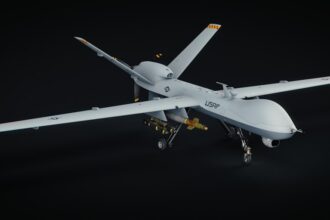Silence is a critical element in the operational effectiveness of submarines. In the underwater realm, where sound travels much farther than in the air, the ability to remain undetected can mean the difference between mission success and failure. Submarines operate in an environment where stealth is paramount; they must evade detection by enemy sonar systems while gathering intelligence or launching strategic strikes.
The quietness of a submarine allows it to approach targets without alerting them, providing a tactical advantage that is essential for modern naval warfare. Moreover, silence enhances the submarine’s ability to gather information. By remaining undetected, submarines can listen to enemy communications and movements, providing invaluable intelligence that can inform broader military strategies.
The importance of silence extends beyond mere stealth; it is a fundamental aspect of a submarine’s operational philosophy. The quieter a submarine can be, the more effective it becomes in fulfilling its mission objectives, whether those involve reconnaissance, deterrence, or direct engagement.
Key Takeaways
- Silence in submarines is crucial for stealth and survival
- Advanced soundproofing techniques are essential for maintaining silence
- Propulsion technology plays a key role in ensuring quiet operation
- Acoustic signature management is critical for evading detection
- The evolution of submarine quietness has revolutionized naval warfare
Advanced Soundproofing Techniques
To achieve the necessary level of silence, modern submarines employ advanced soundproofing techniques that minimize noise generation and transmission. One of the primary methods involves the use of specialized materials that absorb sound waves rather than reflecting them. These materials are strategically placed throughout the submarine’s hull and internal compartments to dampen vibrations caused by machinery and movement.
This sound-absorbing technology is crucial in reducing the acoustic signature of the vessel, making it harder for enemy sonar systems to detect. In addition to sound-absorbing materials, submarines utilize innovative design features that contribute to their stealth capabilities. For instance, the shape of a submarine’s hull is engineered to reduce hydrodynamic noise as it moves through water.
The integration of anechoic coatings—rubber-like materials that cover the exterior of the hull—further enhances sound dampening. These coatings disrupt sonar waves, making it difficult for enemy vessels to pinpoint the submarine’s location. Together, these advanced soundproofing techniques create a formidable barrier against detection, allowing submarines to operate effectively in hostile environments.
Propulsion Technology for Quiet Operation

The propulsion systems of submarines have undergone significant advancements aimed at achieving quieter operation. Traditional diesel-electric engines have been largely replaced by more sophisticated technologies such as nuclear propulsion and advanced electric drive systems. Nuclear-powered submarines, for instance, can operate at high speeds without the need for surface air, allowing them to remain submerged for extended periods while generating minimal noise.
This capability is crucial for maintaining stealth during critical missions. Electric drive systems also play a vital role in enhancing submarine quietness. These systems utilize electric motors powered by batteries or fuel cells, which produce significantly less noise compared to conventional propulsion methods.
By employing these quieter propulsion technologies, submarines can navigate stealthily while maintaining operational readiness. The combination of nuclear power and advanced electric drives represents a significant leap forward in submarine design, enabling them to operate effectively in contested waters without compromising their stealth capabilities.
The Role of Acoustic Signature Management
| Metrics | Value |
|---|---|
| Acoustic Signature | Measure of the sound produced by a vehicle or vessel |
| Acoustic Signature Management | Techniques to reduce or modify the sound produced |
| Importance | Reduces detectability by sonar and other acoustic sensors |
| Applications | Naval vessels, submarines, aircraft, and ground vehicles |
Acoustic signature management is an essential aspect of submarine operations that focuses on minimizing the sounds emitted by a vessel. Every submarine has a unique acoustic signature—a combination of sounds produced by its machinery, hull vibrations, and even crew activities. Understanding and managing this signature is crucial for maintaining stealth and avoiding detection by enemy sonar systems.
Submarine crews are trained to operate their vessels in ways that minimize noise, such as adjusting speed and engine output based on environmental conditions. Furthermore, modern submarines are equipped with sophisticated monitoring systems that continuously assess their acoustic signature. These systems provide real-time feedback to the crew, allowing them to make necessary adjustments to reduce noise levels further.
By actively managing their acoustic signature, submarines can enhance their survivability and effectiveness in various operational scenarios. This proactive approach to noise management underscores the importance of silence in submarine warfare and highlights the technological advancements that support these efforts.
The Evolution of Submarine Quietness
The evolution of submarine quietness has been marked by significant technological advancements and strategic shifts in naval warfare. Early submarines were relatively noisy and easily detectable due to their primitive propulsion systems and construction materials. However, as naval technology progressed throughout the 20th century, so too did the methods employed to enhance submarine stealth.
In recent decades, advancements in materials science and engineering have further refined submarine quietness. The development of composite materials and advanced soundproofing techniques has enabled modern submarines to achieve unprecedented levels of stealth.
Additionally, the integration of digital technologies has allowed for more precise control over machinery and operations, reducing noise generation significantly. This ongoing evolution reflects the increasing importance of stealth in naval strategy and highlights the continuous efforts made by nations to enhance their underwater capabilities.
The Impact of Quiet Submarines on Naval Warfare

The impact of quiet submarines on naval warfare cannot be overstated. Their ability to operate undetected allows them to conduct surveillance missions, gather intelligence, and launch surprise attacks with minimal risk of detection. This stealth capability fundamentally alters the dynamics of naval engagements, forcing adversaries to adopt new strategies and technologies to counteract the threat posed by silent submarines.
As a result, quiet submarines have become a cornerstone of modern naval power. Moreover, the presence of quiet submarines can serve as a powerful deterrent against potential aggressors. Nations equipped with advanced submarine fleets can project power and influence without resorting to overt military action.
The mere knowledge that a silent submarine could be lurking nearby can alter an adversary’s calculations and decision-making processes. This psychological aspect of submarine warfare underscores the strategic significance of maintaining a fleet of quiet vessels capable of operating effectively in contested waters.
Challenges in Maintaining Submarine Silence
Despite advancements in technology and design, maintaining silence in submarines presents several challenges. One significant issue is the inherent noise generated by onboard machinery and equipment. Even with advanced soundproofing techniques, vibrations from engines, pumps, and other systems can still escape into the surrounding water, potentially compromising stealth.
Engineers continually work to refine these systems and reduce their noise output, but achieving complete silence remains an elusive goal. Environmental factors also play a role in submarine silence. Ocean currents, temperature variations, and underwater topography can all affect how sound travels through water, complicating detection efforts for both submarines and enemy sonar systems.
Additionally, human factors such as crew movement and operational procedures can inadvertently generate noise that may compromise stealth. Training crews to operate quietly while maintaining efficiency is an ongoing challenge that requires constant attention and adaptation.
Future Developments in Submarine Quietness
Looking ahead, future developments in submarine quietness are likely to focus on integrating cutting-edge technologies that enhance stealth capabilities further. Innovations in materials science may lead to even more effective sound-absorbing materials that can be applied to submarine hulls and internal structures. Additionally, advancements in artificial intelligence could enable more sophisticated acoustic signature management systems that learn from environmental conditions and adapt operations accordingly.
Furthermore, research into alternative propulsion methods may yield quieter solutions that reduce noise generation even further. Concepts such as magnetohydrodynamic propulsion or advanced bio-inspired designs could revolutionize how submarines operate underwater.
The Role of Submarine Crew in Maintaining Silence
The crew aboard a submarine plays a pivotal role in maintaining silence during operations. Each member is trained not only in their specific duties but also in the importance of stealth as a collective objective. From navigating through challenging underwater terrain to managing onboard systems quietly, every action taken by the crew contributes to the overall acoustic signature of the vessel.
This emphasis on teamwork ensures that all personnel understand their responsibility in preserving silence. Moreover, regular drills and training exercises are conducted to reinforce silent operation protocols among crew members. These exercises simulate various scenarios where maintaining silence is critical, allowing crew members to practice operating under pressure while minimizing noise generation.
By fostering a culture of awareness regarding noise discipline, submarine crews become adept at executing their missions without compromising stealth—a vital skill set that enhances the effectiveness of modern submarines.
Comparing US Submarines with Other Nations’ Submarines
When comparing US submarines with those from other nations, several key differences emerge regarding design philosophy, technology integration, and operational capabilities. The United States has invested heavily in developing advanced submarine technologies that prioritize stealth and versatility. For instance, US Navy submarines often feature cutting-edge soundproofing materials and propulsion systems designed specifically for quiet operation.
In contrast, some other nations may prioritize different aspects of submarine design based on their strategic needs or available resources. While many countries have made significant strides in enhancing their submarine capabilities, US submarines often lead in terms of technological sophistication and operational flexibility. This disparity underscores the competitive nature of global naval power dynamics and highlights the ongoing race for superiority beneath the waves.
The Strategic Advantage of Silent US Submarines
The strategic advantage offered by silent US submarines is profound and multifaceted. Their ability to operate undetected allows them to conduct intelligence-gathering missions with minimal risk while also serving as a deterrent against potential adversaries. The presence of these silent vessels enhances the United States’ ability to project power globally while maintaining a posture of readiness for various contingencies.
Furthermore, silent US submarines play a crucial role in joint military operations with allied forces. Their stealth capabilities enable them to support surface fleets and air operations without revealing their position or intentions. This synergy between different branches of the military amplifies overall effectiveness during complex operations and reinforces alliances among nations committed to maintaining maritime security.
In conclusion, silence remains an indispensable asset for modern submarines, shaping their design, operation, and strategic significance within naval warfare. As technology continues to evolve, so too will the methods employed to achieve greater levels of quietness—ensuring that submarines remain a formidable force beneath the waves for years to come.
The stealth capabilities of U.S. submarines have long been a subject of intrigue and technological advancement. One of the key reasons these submarines are so quiet is due to the sophisticated sound-dampening technologies and design innovations that minimize noise emissions, making them nearly undetectable underwater. For a deeper understanding of the technological advancements that contribute to the stealth of U.S. submarines, you can explore a related article on this topic by visiting In The War Room. This resource provides insights into the engineering marvels and strategic importance of maintaining acoustic superiority in naval operations.
WATCH THIS! America’s Nuclear Navy Was Born From Espionage
FAQs
What makes US submarines so quiet?
US submarines are designed with advanced technology and engineering to minimize noise and acoustic signatures. This includes sound isolation, vibration reduction, and the use of quiet propulsion systems.
How do US submarines reduce their acoustic signatures?
US submarines employ various techniques to reduce acoustic signatures, such as using specially designed propellers, sound-absorbing materials, and advanced hull designs to minimize noise and make them harder to detect underwater.
What role does technology play in making US submarines quiet?
Technology plays a crucial role in making US submarines quiet. Advanced sonar systems, quieting technologies, and innovative engineering solutions are used to reduce noise and improve stealth capabilities.
Why is it important for US submarines to be quiet?
The quietness of US submarines is crucial for their stealth and survivability. By minimizing their acoustic signatures, submarines can operate undetected and carry out their missions effectively, whether it’s surveillance, intelligence gathering, or strategic deterrence.
How do US submarines compare to submarines from other countries in terms of quietness?
US submarines are widely regarded as some of the quietest in the world. Their advanced technology and continuous research and development efforts give them a significant advantage in terms of stealth and acoustic performance compared to submarines from other countries.




